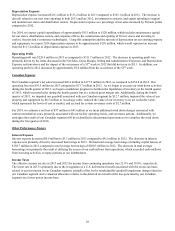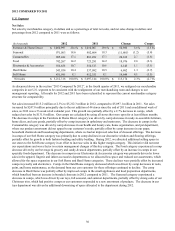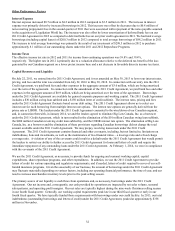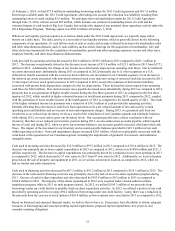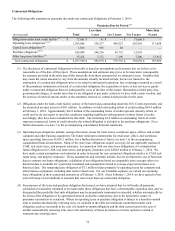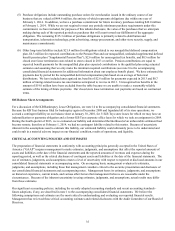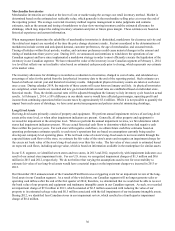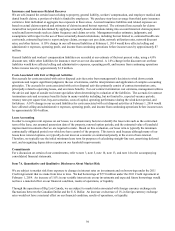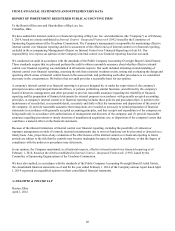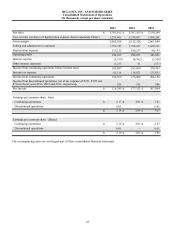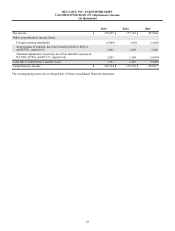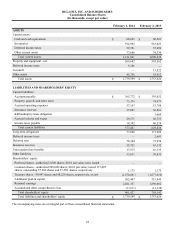Big Lots 2013 Annual Report Download - page 178
Download and view the complete annual report
Please find page 178 of the 2013 Big Lots annual report below. You can navigate through the pages in the report by either clicking on the pages listed below, or by using the keyword search tool below to find specific information within the annual report.
36
Merchandise Inventories
Merchandise inventories are valued at the lower of cost or market using the average cost retail inventory method. Market is
determined based on the estimated net realizable value, which generally is the merchandise selling price at or near the end of
the reporting period. The average cost retail inventory method requires management to make judgments and contains
estimates, such as the amount and timing of markdowns to clear slow-moving inventory and the estimated allowance for
shrinkage, which may impact the ending inventory valuation and prior or future gross margin. These estimates are based on
historical experience and current information.
When management determines the saleability of merchandise inventories is diminished, markdowns for clearance activity and
the related cost impact are recorded at the time the price change decision is made. Factors considered in the determination of
markdowns include current and anticipated demand, customer preferences, the age of merchandise, and seasonal trends.
Timing of holidays within fiscal periods, weather, and customer preferences could cause material changes in the amount and
timing of markdowns from year to year. During 2013, we announced our intentions to wind down the operations of our
Canadian segment and have since implemented a markdown strategy in order to most efficiently execute the liquidation of the
inventory in our Canadian segment. We have reduced the value of the inventory in our Canadian segment at February 1, 2014
to a level that reflects our net realizable value based on estimated cash proceeds prior to closing, which represents our estimate
of its market value.
The inventory allowance for shrinkage is recorded as a reduction to inventories, charged to cost of sales, and calculated as a
percentage of sales for the period from the last physical inventory date to the end of the reporting period. Such estimates are
based on both our current year and historical inventory results. Independent physical inventory counts are taken at each store
once a year. During calendar 2014, the majority of these counts will occur between January and July. As physical inventories
are completed, actual results are recorded and new go-forward shrink accrual rates are established based on individual store,
historical results. Thus, the shrink accrual rates will be adjusted throughout the January to July inventory cycle based on actual
results. At February 1, 2014, a 10% difference in our shrink reserve would have affected gross margin, operating profit and
income from continuing operations before income taxes by approximately $3.4 million. While it is not possible to quantify the
impact from each cause of shrinkage, we have asset protection programs and policies aimed at minimizing shrinkage.
Long-Lived Assets
Our long-lived assets primarily consist of property and equipment. We perform annual impairment reviews of our long-lived
assets at the store level, or when other impairment indicators are present. Generally, all other property and equipment is
reviewed for impairment at the enterprise level. When we perform the annual impairment reviews, we first determine which
stores had impairment indicators present. We use actual historical cash flows to determine which stores had negative cash
flows within the past two years. For each store with negative cash flows, we obtain future cash flow estimates based on
operating performance estimates specific to each store’s operations that are based on assumptions currently being used to
develop our company level operating plans. If the net book value of a store's long-lived assets is not recoverable through the
expected future cash flows of the store, we estimate the fair value of the store's assets and recognize an impairment charge for
the excess net book value of the store's long-lived assets over their fair value. The fair value of store assets is estimated based
on expected cash flows, including salvage value, which is based on information available in the marketplace for similar assets.
In our U.S. segment, we identified seven stores and two stores, in 2013 and 2012, respectively, with impairment indicators as a
result of our annual store impairment tests. For our U.S. stores, we recognized impairment charges of $1.3 million and $0.6
million in 2013 and 2012, respectively. We do not believe that varying the assumptions used to test for recoverability to
estimate fair value of our long-lived assets would have a material impact on the impairment charges we incurred in 2013 or
2012.
Our December 2013 announcement of the Canadian Wind Down was a triggering event for an impairment review of the long-
lived assets in our Canadian segment. As a result of the wind down, our Canadian segment will no longer generate sales or
operating cash inflows after the end of the first quarter of 2014; therefore, we determined that we would not be able to recover
the book value of our property and equipment and tradename intangible assets in our Canadian segment. As such, we recorded
an impairment charge of $7.0 million in 2013, which consisted of $6.5 million associated with reducing the value of our
property to its estimated salvage value and $0.5 million associated with the full impairment of our tradename intangible assets.
During 2012, we identified four Canadian stores in our impairment review, which resulted in a fourth quarter impairment
charge of $0.4 million.





